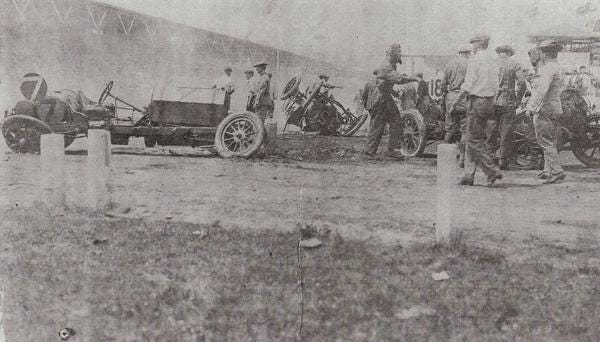The Indy 500's First Multi-Car Wreck
Search
Featured Article
Image of The Week
This photograph is of the most spectacular accident that occurred during the first Indianapolis 500. The incident was triggered when the Case racer of Joe Jagersberger broke a steering arm on the front stretch. The car was high on the running surface and skirting the concrete wall.

The Indianapolis 500’s first multi-car wreck.
This might have been the extent of it except that his riding mechanic, Charles Anderson, inexplicably leaped from his seat to the track. The car was still carrying some speed, far too much for him to gain his footing on the bricks.
Anderson immediately tumbled to the ground to be struck by the car’s left rear wheel. He was only slightly injured, but Harry Knight, who had just completed his 90th lap, swerved wildly for fear of striking the man.
This abrupt turn sent Knight skidding into the pits where his Westcott racer struck the Apperson of Herb Lytle and then bumped into the #18 Fiat of Eddie Hearne. The Fiat was able to continue but the other three racers were too damaged to return to the competition.
This was the biggest multi-car mishap of the contest, but its impact apparently was more far-reaching than simply wrecking cars, inflicting minor injuries, and providing thrills for those in the packed grandstands. It may have contributed to the controversial race finish where Ralph Mulford’s Lozier team protested Ray Harroun’s victory with the Marmon Wasp.
The story goes that “officials” timing and scoring the race were distracted by the melee and several competitors’ laps went unscored. This was complicated by the indefensible decision to staff those roles not with experienced race officials, but with representatives of those of elite social standing in Indianapolis. These men were thoroughly distracted by the sudden spectacle that was well within their view.
How much of a factor all this was in determining the outcome of one of the most historically important, iconic contests in all of motorsport will forever remain a mystery. Adding fuel to the fire was Speedway Founder & President Carl Fisher’s decision to destroy all the records in a fire. This was after an hours-long post-race meeting in an executive suite in the Claypool Hotel where tempers flared.
All of this has been reported before and provided much nourishment for iconoclasts and conspiracy theorists who can’t resist disparaging. Our guess is that Fisher was embarrassed by the lack of professionalism within his officiating team and wanted to rid himself of any evidence that frankly, they were unqualified.
Given newspaper coverage of the day, it appears there could be little chance that Mulford, who had numerous tire failures necessitating excruciatingly slow tours of the course to get to his pit could have won. He was, for the most part, faster on the track, but Harroun had calculated a steady pace to manage his rubber and conserve fuel. The Marmon team only changed the right rear Firestone while the other three endured the full distance.
Again, though, it is little more than an interesting story today. The official winner has never changed, and never will.
If you click thru and you can read up and use the embedded links on the page that fully reveals this image to discover amazing background on the race and the drivers involved in this accident. That includes complete Indianapolis Star and Indianapolis News coverage of the entire month of May 1911 at the Brickyard.
